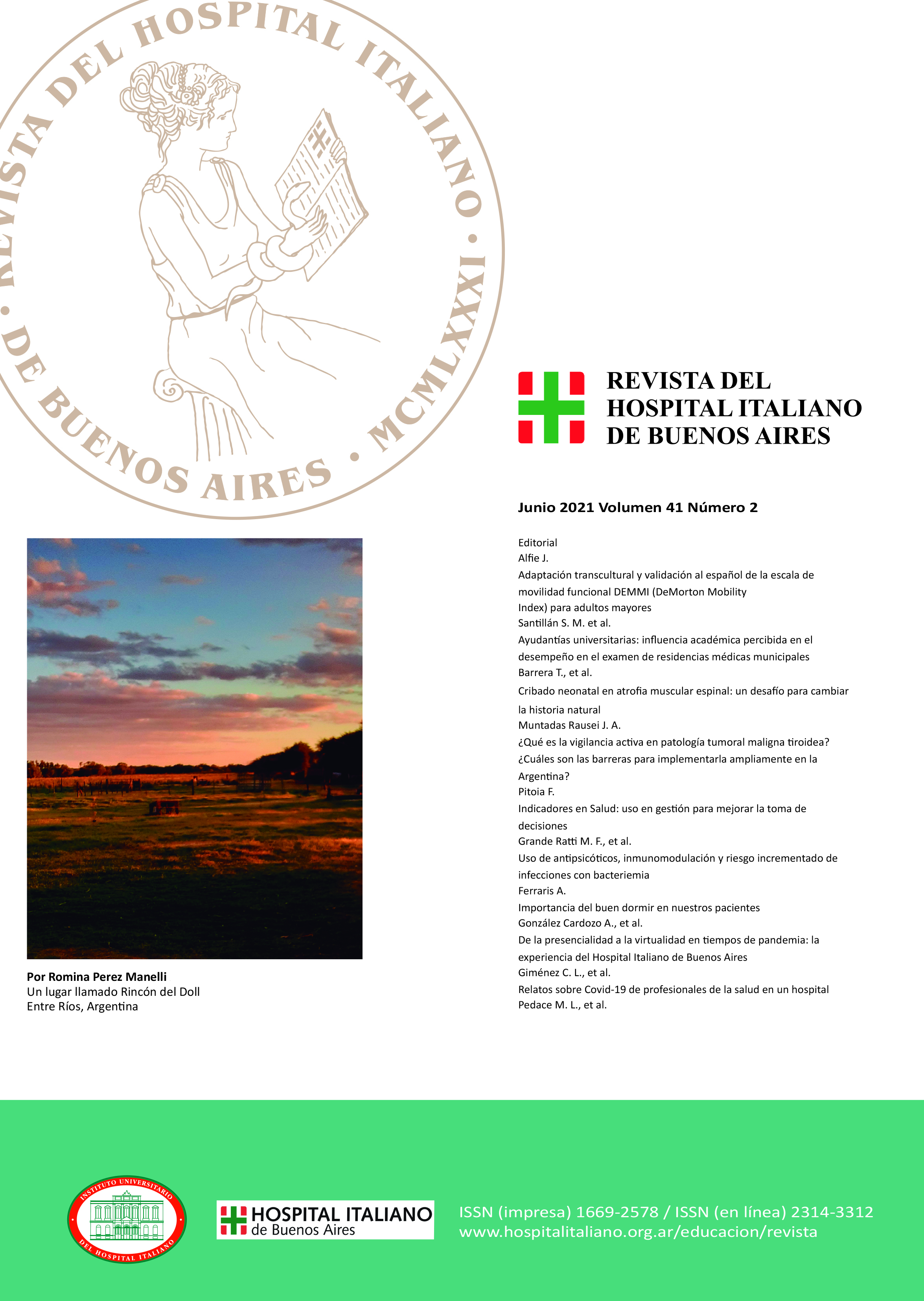From face-to-face to virtuality in pandemic times: the experience of the Hospital Italiano de Buenos Aires
Main Article Content
Abstract
On March 11, 2020, the World Health Organization (WHO) declared COVID-19 a pandemic, dramatically affecting health care. Measures such as social distancing and quarantine were adopted globally. This new context represented a huge challenge for Health Information Systems (HIS) that had to adapt quickly, facing an inescapable reason to fully embrace the digital transformation. There is a need to explore the digital technologies used during the pandemic and consider them for continued use over time or cyclically in the event of recurring outbreaks. Digital tools have been used for the provision of telemedicine services, remote patient monitoring, digital communication between political leaders and scientific authorities, data monitoring to analyze the spread and evolution of COVID-19, etc. Countries and organizations have promoted the use of technological solutions with different limitations. The Hospital Italiano de Buenos Aires has a history of more than 20 years in technological implementations and innovations, however, the pandemic prompted a series of adaptations in its SIS. The objective of this work was to describe said digital adaptation process from March to December 2020, and to identify the main results using a sociotechnical model. Sittig´model was used, which includes 8 dimensions: Infrastructure, Clinical Content, Human-Computer Interface, People, Communication and Processes, Regulations, Organizational Characteristics and Internal Policies, and Measurement and Monitoring.
Downloads
Article Details
Section

This work is licensed under a Creative Commons Attribution-NonCommercial-ShareAlike 4.0 International License.
How to Cite
References
Bokolo AJ. Use of telemedicine and virtual care for remote treatment in response to COVID-19 pandemic. J Med Syst. 2020 15;44(7):132. doi: 10.1007/s10916-020-01596-5. DOI: https://doi.org/10.1007/s10916-020-01596-5
Mojica-Crespo R, Morales-Crespo MM. Pandemia COVID-19, la nueva emergencia sanitaria de
preocupación internacional: una revisión. Semergen. 2020;46 Suppl 1:65–77. doi: 10.1016/j.semerg.2020.05.010. DOI: https://doi.org/10.1016/j.semerg.2020.05.010
Argentina. Presidencia de la Nación. Decreto 624/20: Aislamiento social preventivo y obligatorio [Internet]. Buenos Aires: InfoLeg; 2020/08/02 [citado 2021 mayo 20]. Disponible en: http://servicios.infoleg.gob.ar/infolegInternet/anexos/340000-344999/340612/norma.htm.
Mahajan V, Singh T, Azad C. Using telemedicine during the COVID-19 pandemic . Indian Pediatr. 2020;57(7):658-661. DOI: https://doi.org/10.1007/s13312-020-1895-6
Golinelli D, Boetto E, Carullo G, et al. Adoption of digital technologies in health care during the COVID-19 pandemic: systematic review of early scientific literature. J Med Internet Res. 2020;22(11):e22280. doi: 10.2196/22280. DOI: https://doi.org/10.2196/22280
Monaco A, Palmer K, Faber NH, et al. Digital health tools for managing noncommunicable diseases during and after the COVID-19 pandemic: perspectives of patients and caregivers. J Med Internet Res. 2021;23(1):e25652. doi: 10.2196/25652. DOI: https://doi.org/10.2196/25652
Kalhori SR, Bahaadinbeigy K, Deldar K, et al. Digital health solutions to control the COVID-19 pandemic in countries with high disease prevalence: literature review. J Med Internet Res. 2021;23(3):e19473. doi: 10.2196/19473. DOI: https://doi.org/10.2196/19473
Economic Commission for Latin America and the Caribbean. Universalizar el acceso a las tecnologías digitales para enfrentar los efectos del COVID-19 [Internet]. [Ginebra]: Naciones Unidas; CEPAL; 2020 (Informe Especial COVID-19; no, 7) [citado 2021 mayo 20]. Disponible en: http://dx.doi.org/10.18356/9789210054782. DOI: https://doi.org/10.18356/9789210054782
Vilnitzky N, Nessi M, Franco M, et al. Implementación de una historia clínica informática en unidades febriles de urgencia [Internet]. Trabajo presentado en: 49 Jornadas Argentinas de Informática. CAIS Congreso Argentino de Informática y Salud. 2020 octubre 19-30; Buenos Aires [citado 2021 mayo 18]. Disponible en: https://49jaiio.sadio.org.ar/pdfs/cais/CAIS%2018.pdf.
Gongález Bernaldo de Quirós F, Luna D, Baum A, et al. Incorporación de tecnologías de la información y de las comunicaciones en el Hospital Italiano de Buenos Aires [Internet]. Santiago de Chile: Naciones Unidas; 2012 [citado 2021 febrero 21]. Disponible en: http://hdl.handle.net/11362/3959.
Sittig DF, Singh H. A new sociotechnical model for studying health information technology in complex adaptive healthcare systems. Qual Saf Health Care. 2010;19 Suppl 3:i68–74. doi: 10.1136/qshc.2010.042085. DOI: https://doi.org/10.1136/qshc.2010.042085
Argentina. Ministerio de Salud. Resolución 696/2020. Prescripción de medicamentos [Internet]. Buenos Aires: InfoLeg; 2020 marzo 31 [citado 2021 mar 10]. Disponible en: http://servicios.infoleg.gob.ar/infolegInternet/verNorma.do?id=335983.
Argentina.gob.ar [Internet]. [cited 2021Mar 10]. Available from: https://www.
argentina.gob.ar/
Grange ES, Neil EJ, Stoffel M, et al. Responding to COVID-19: the UW Medicine Information Technology Services Experience. Appl Clin Inform. 2020;11(2):265–75. doi: 10.1055/s-0040-1709715. DOI: https://doi.org/10.1055/s-0040-1709715
Reeves JJ, Hollandsworth HM, Torriani FJ, et al. Rapid response to COVID-19: health
informatics support for outbreak management in an academic health system. J Am Med Inform Assoc. 2020;27(6):853-859. doi: 10.1093/jamia/ocaa037. DOI: https://doi.org/10.1093/jamia/ocaa037
Hincapié MA, Gallego JC, Gempeler A, et al. Implementation and usefulness of telemedicine during the COVID-19 pandemic: a scoping review. J Prim Care Community Health. 2020 11:2150132720980612. doi: 10.1177/2150132720980612. DOI: https://doi.org/10.1177/2150132720980612
Saavedra Grandez SG. Intervención de las TICs en redefinición de atención externa en Hospital II-2 Tarapoto en épocas de pandemia Covid 19. Revista Científica de Sistemas e Informática. 2021;1(1):58–68. doi: 10.51252/rcsi.v1i1.120 DOI: https://doi.org/10.51252/rcsi.v1i1.120
Caetano R, Silva AB, Guedes ACCM,et al. Desafios e oportunidades para telessaúde em tempos da pandemia pela COVID-19: uma reflexão sobre os espaços e iniciativas no contexto brasileiro. Cad Saúde Pública. 2020;36(5). doi: 10.1590/0102-311X00088920. DOI: https://doi.org/10.1590/0102-311x00088920
Curioso WH, Galán-Rodas E. El rol de la telesalud en la lucha contra el COVID-19 y la evolución del marco normativo peruano. Acta Méd Peru. 2020;37(3):366-375. doi: 10.35663/amp.2020.373.1004. DOI: https://doi.org/10.35663/amp.2020.373.1004
Ye J. The role of health technology and informatics in a global public health emergency: practices and implications from the COVID-19 pandemic. JMIR Med Inform. 2020;8(7):e19866. doi: 10.2196/19866. DOI: https://doi.org/10.2196/19866
Dixon BE, Grannis SJ, McAndrews C, et al. Leveraging data visualization and a statewide health information exchange to support COVID-19 surveillance and response: application of public health informatics. J Am Med Inform Assoc. 2021 Jan 22;ocab004. doi: 10.1093/jamia/ocab004. DOI: https://doi.org/10.1093/jamia/ocab004
Kraus S, Schiavone F, Pluzhnikova A, et al.. Digital transformation in healthcare: analyzing the current state-of-research. J Bus Res. 2021;123:557-667. doi: 10.1016/j.jbusres.2020.10.030. DOI: https://doi.org/10.1016/j.jbusres.2020.10.030

